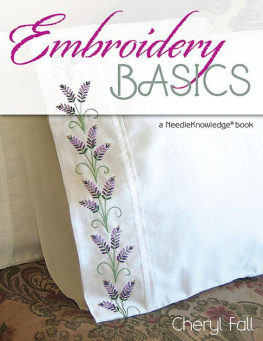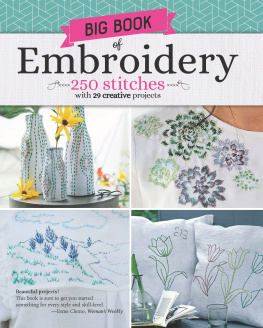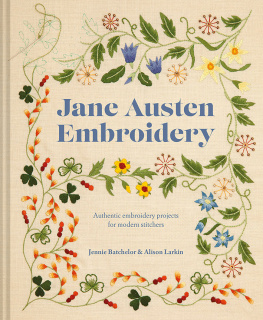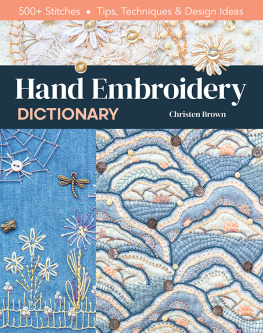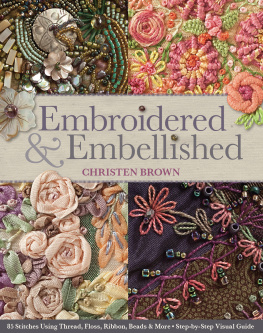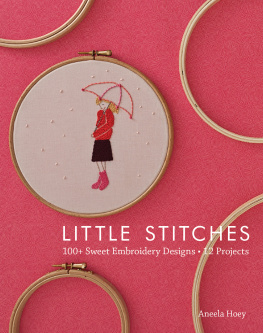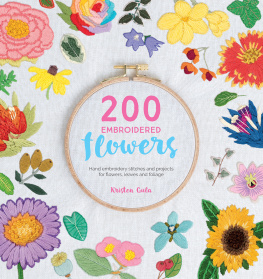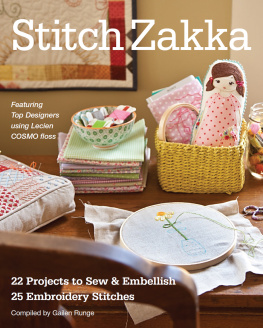

Contents
Surface Embroidery Projects
Counted-Thread Embroidery Projects


T he popularity of embroidery has been soaring over the past few years and with good reason. Embroidery is easy, fun, and doesnt require you to schlep around a huge amount of tools or supplies, making this form of needlework portable and easy to tuck into your handbag.
To create an embroidered project, youll need some basic supplies, which can be found in most hobby store chains as well as specialty needlework shops.
Here youll find information on the various threads and fibers, fabrics, and tools needed for embroidery, as well as recommendations on a few items that may not be necessary, but are nice to have on hand.
Threads and Fibers
Thread is to the embroiderer what paint is to the artist. Its the medium that turns a blank fabric into a work of art. There are many different types and sizes of threads available for embroidery, from soft cottons with a matte or glossy finish to wooly textured threads and metallic fibers or holographic threads that dazzle. Threads can be a single color or combine several complementary or contrasting colors twisted in the fibers, or along the length of the thread using dyed effects. The type of thread chosen depends entirely on the look you want to achieve, and the possibilities are endless! Here are some of the popular choices for hand embroidery.
Embroidery Floss
Often referred to as six-strand floss , or just shortened to floss , this is a mercerized cotton thread consisting of six individual strands. These strands can be separated and used singly or in groups, depending on the desired thickness of the finished embroidery design. Floss is available in a wide range of colors. For example, the DMC Color Card features 454 solid, 18 variegated, and 36 multicolored varieties.
Embroidery floss is available on a pull skein. You simply pull the end of the thread to length and cut. When using floss, lengths should be no longer than the length of your arm, or about 18 inches. Longer lengths are harder to stitch, can cause wear on the thread from the repeated in-and-out motion of stitching, and can tangle easier than shorter lengths.
TIP: Completely separate all strands of embroidery floss and regroup them before using them. This will result in a smoother finished stitch and help prevent tangling.
Pearl Cotton
Pearl cotton is available in skeins or rolled on balls and is available in a variety of weights, from very fine to thick and chunky. The size of pearl cotton you choose depends on the look you want to achieve.
Finer pearl cotton weights, such as sizes 80 through 20, are ideal while using drawn thread techniques and mid-weight varieties, such as size 12 through 5, are better suited to surface embroidery and cross-stitch or counted-thread projects. The thickest pearl cotton is size 3, which works best on chunky, rustic projects worked in surface embroidery, or in counted-thread techniques on coarse or loosely woven fabrics, such as 7- to 10-count evenweave or 6- to 11-count Aida fabric.


When purchasing pearl cotton (or any other thread), remember that the higher the number, the finer the thread. For example, size 12 pearl cotton thread is going to be much thinner than a size 3 pearl cotton thread.
Wool, Silk, Bamboo, and Linen Threads
A variety of natural fibers are available in both floss and pearl types as well as single-strand yarn, and include threads made from fine wools, silk and silk blends, linen, and bamboo. Wool varieties are most commonly available as a floss, tapestry, or Persian yarn for crewel and needlepoint projects. Bamboo and linen are available in floss, and silk is available in either a floss or pearl variety. These threads can be expensive, but are a joy to stitch with.

Thread Conditioners and Beeswax
Threads such as rayon, satin, and Mylar can be unruly to work with and may snag or tangle back on themselves as you stitch. Using a thread conditioner, like Thread Heaven, or beeswax can help tame the beast. Conditioners and beeswax lubricate the thread, making it easier to pull through the fabric, and also help keep the fibers in the thread together in a tidy bundle.
To use thread conditioner or beeswax, simply run your working thread along the surface of the conditioner after threading your needle and stitch normally. Do not apply too much or your thread could end up gummy or sticky. A fine, invisible layer is all you need, and the conditioner should not be noticeable on the surface of the thread.
Novelty, Metallic, and Holographic
Threads
Put some razzle in your dazzle! Use novelty, metallic, or holographic embroidery threads to add a sparkling element to your creations. These threads come in a variety of materials and weights, including multicolored, twisted fibers in narrow or chunky weights, a single narrow filament, or flat ribbon.
Novelty threads can be used to add unique effects to a project, including glow-in-the-dark properties, a pearlized luster, or a dazzling sheen to the stitching in a design. These threads can be used alone in a project or combined with other threads in your needle as a blending filament.
Metallic threads are available in floss and pearl cotton types, as well as single-strand varieties in gold, silver, bronze, copper, and antique metallic varieties. Holographic threads can be a single color or feature a rainbow of colors in a single thread and are available in bright colors as well as metallic styles.
Wired Threads
Fiber-wrapped wire threads can be used to add dimension and texture to an embroidery project. Two popular wired threads are DMCs Color Infusions Memory Thread and Kreiniks HotWire Thread.
Wired threads are not embroidery threads perse. These threads are not worked through the fabric, but instead are secured to the top of the fabric by couching them into place. These threads add an extra layer of dimension to an embroidery project when used to outline key components of a design.


Determining Stitch Gauge
While Im designing a project, I often stitch a sample to test the gauge to make sure the thread I have chosen is best suited to the design or type of project. In this example, I have worked the same stitch over the same number of threads in an evenweave fabric. As you can see, the look is very different, depending on the thread chosen.
Next page
